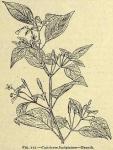 The dried ripe fruit of Cap'sicum frutescens Blume, deprived of its calyx.
The dried ripe fruit of Cap'sicum frutescens Blume, deprived of its calyx.
BOTANICAL CHARACTERISTICS.—A small, rough, branched shrub, 1 to 2 feet high. Leaves ovate or lanceolate, entire, hairy. Flowers small, white, solitary, axillary, drooping. Capsule deep red, very pungent.
SOURCE.—Tropical America and Asia; cultivated.
DESCRIPTION OF DRUG.—The fruits vary in shape and size, but those most generally used are oblong, wrinkled, pendulous, pod-like berries, the largest (American), about the thickness of a finger, with a long, recurved apex; pericarp bright red, sometimes yellow, thin, translucent; it incloses two or three cells and contains numerous flat, reniform, whitish seeds, which are surrounded by a dry, loose parenchyma, and fastened to a slender placenta; odor peculiar, very irritating, especially in powder or in the fresh state; taste fiery.
Powdered capsicum of the market consists of several species of capsicum ground up together. It is of a reddish color. This is especially true of the American capsicum, which is grown to a limited extent in Texas and Mexico, where it is ground and called "paprika." The African (Zanzibar) pod yields a powder of a greenish- or brownish-yellow color. The commercial variety known as Bombay yields a powder of a more yellowish color than the African, but is not at all like the reddish-orange powder resulting from the American pod. This color fades and disappears on long exposure to the light. It is often adulterated with sawdust and red lead; the former may be detected with the microscope, the latter by digesting the powder in dilute nitric acid, filtering, and adding a solution of sodium sulphate, which will throw down a white precipitate if any lead oxide is present.
STRUCTURE.—A microscopical examination for the distinction of the above varieties has been suggested. This test is based upon the size and character of the cells of the outer layer of the epidermis, the American having, in dimension, the largest and the African the smallest cell in the outer layer of the pericarp. The value of capsicum can be estimated only by assay.
Powder.—Characteristic elements: See Part iv, Chap. I, B.
CONSTITUENTS.—Capsaicin, C9H14O2, an exceedingly active pungent principle existing principally in the pericarp; a volatile alkaloid having an odor like coniine, supposed to be the result of a decomposition process during ripening of the fruit, as it does not exist in the unripe fruit- fixed oil, fat acids (oleic, palmitic, and stearic), and a red coloring matter (a cholesterin ester of the fat acids). Ash, not exceeding 7 per cent.; insoluble in HCl 1 per cent.
Capsicum should yield not less than 15 per cent. of non-volatile ether extract, soluble in ether, U.S.P. IX.
Preparation of Capsaicin.—Treat petroleum ether extract with alkali; pass CO2 through the solution; collect crystals after standing. Soluble in ether, alcohol, benzene, and fixed oils.
ACTION AND USES.—Externally rubefacient. Internally a powerful stimulant. Its chief value medicinally is in the treatment of malignant sore throat and scarlet fever, used internally and as a gargle. Dose: 1 to 5 gr. (0.06 to 0.3 Gm.).
- OFFICIAL PREPARATIONS.
- Tinctura Capsici (10 per cent.),Dose: 15 to 30 drops (1 to 2 mils).
- Oleoresina Capsici 1/4 to 1 drops (0.016:2 to 0.065 mil).

